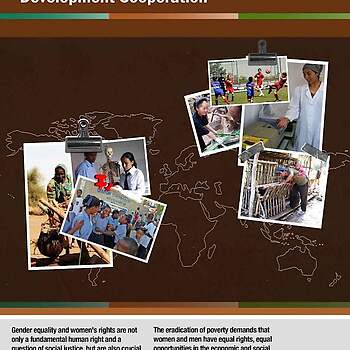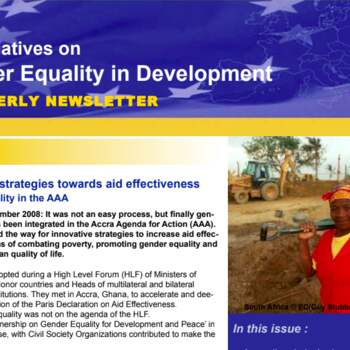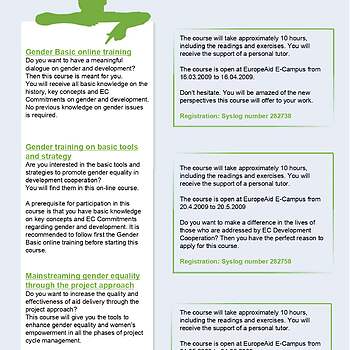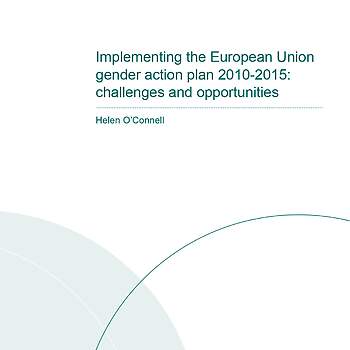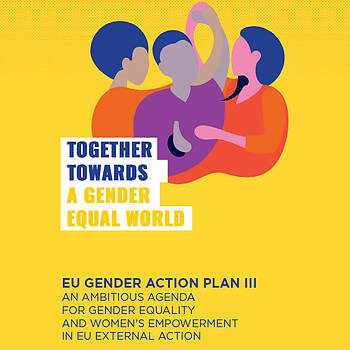Brief history of EU development aid
On 1 January 2001 the EuropeAid Cooperation Office (AIDCO) had been founded with the mission of implementing the EU external aid programmes around the world. In 2011 the Directorate-General for Development and Cooperation (DEVCO) was formed following the merger of AIDCO with the Directorate-General for Development and Relations with African, Caribbean and Pacific States (DEV). On 16 January 2021, DEVCO officially became DG International Partnerships (DG INTPA). This new name underlined the importance of international partnerships for the EU in working towards the eradication of poverty, the achievement of sustainable development objectives and the promotion of democracy, human rights, and the rule of law.
Gender in EU external policies
In the first years of AIDCO gender issues were marginally addressed, without a clear policy. Nevertheless, since 2004 there was a Toolkit for gender mainstreaming in EU development cooperation and various specific gender activities. For example, in 2004 AIDCO had launched a Call for Proposals with the objective of integrating gender issues in development cooperation. Most applicants for these grants were development NGOs based in EU member states, proposing actions in eligible developing countries.
In 2005 the EU Member States and the European Commission (EC) published a common vision on development cooperation: The European Consensus on Development. This declaration defined the common values, principles, objectives and means to eradicate world poverty. One of its goals was “to promote gender equality and empower women”. In article 11 it declared that “The empowerment of women is key to all development and gender equality should be a core part of all policy strategies”. This declaration saw gender equality as a prerequisite for poverty eradication, as elaborated in article 104:
Article 104: “Equality between men and women and the active involvement of both genders in all aspects of social progress are key prerequisites for poverty reduction. The gender aspect must be addressed in close conjunction with poverty reduction, social and political development and economic growth, and mainstreamed in all aspects of development cooperation. Gender equality will be promoted through support to equal rights, access and control over resources, and political and economic voice.”
Source: The European Consensus on Development (2005)
Building upon this European Consensus on Development, and pushed by the lobby and advocacy of civil society organisations, several policy documents on gender issues were formulated and approved by the Council of Ministers of Foreign Affairs of the European Union (EU). This was an important milestone in the EU’s commitment to gender equality within development cooperation. The main policy document was the Communication of the EC on Gender Equality and Women Empowerment in Development Cooperation (8 March 2007), the so-called 8th of March Communication. Other policy documents of 2008 were The EU guidelines on violence against women and girls and combating all forms of discrimination against them, and The Comprehensive approach to the EU implementation of the UNSCRs 1325 and 1820 on Women, Peace and Security. The 8th of March Communication was based on a twin-track approach consisting of gender mainstreaming and the promotion of gender specific actions. It did not include targets, indicators and accountability mechanisms. Therefore, gender experts from EU member states called for a Plan of Action to operationalize the 8th of March Communication, facilitating its implementation.
First EU Gender Action Plan 2010 - 2015
In 2010 the EU adopted its first Action Plan on Gender Equality and Women Empowerment in Development (2010-2015)” (GAP-I). The main objectives of GAP-I, aligned with international commitments to women’s rights and the 8th of March Communication, were:
- strengthening the lead role of the EU in promoting gender equality and women's empowerment in development (GEWE)
- ensure adequate human and financial resources for GEWE
- include gender equality issues systematically on the agenda of dialogues with partner countries
- mainstreaming gender equality in EU funded projects, sector programmes and budget support
- prioritization of in-country Non-State Actors.
The GAP-I included 37 actions and 53 indicators. It foresaw an accountability system where Member States, the Commission, the European External Action Service (EEAS – EU’s diplomatic service) and the EU Delegations had to report annually on progress in implementing the indicators for which they were responsible. For the first annual report on the implementation of GAP-I almost all EU Delegations and EU Member States that are members of the OECD’s Development Assistance Committee, except for Luxembourg and The Netherlands, submitted their report. However, one year later the Netherlands came also on board and submitted information for the 2nd year of GAP-reporting.
Second EU Gender Action Plan 2016 – 2020 and new policy of 2017
In 2015 the second Gender Action Plan (GAP-II) was endorsed by the Council to the EU: Measures for Gender Equality and Women's Empowerment: Transforming the Lives of Girls and Women through EU External Relations 2016-2020. The GAP-II pursued an “Institutional Culture Shift in the European Union External Relations.”
In 2017 the New European Consensus on Development: Our World, our Dignity, our Future was adopted by the EU Council. According to this policy, the EU and its Member States were committed to “promote women’s and girls’ rights, gender equality and the empowerment of women and girls and their protection as a priority across all areas of action.” In line with the 2030 Agenda (the Sustainable Development Goals) the policy seeks “to bring about sustainable development and to accelerate transformation by placing an emphasis on cross-cutting elements of development policy such as gender equality, youth, investment and trade, sustainable energy and climate action, good governance, democracy, rule of law and human rights, and migration and mobility.” This new EU consensus is more committed to gender equality than the previous one. It places gender equality at the core of its priorities and considers it vital for achieving the SDGs and the whole 2030 Agenda.
Third EU Gender Action Plan 2021 – 2025
In 2020 the Gender Action Plan 2021-2025 (GAP-III) was drafted, titled An ambitious agenda for gender equality and women’s empowerment in EU external action”. However, no consensus could be reached on the draft Council conclusions. The Presidency concluded that reaching consensus was impossible and thus only 24 delegations of the EU Member States supported the GAP-III, this included the Netherlands. GAP-III has five pillars, representing a gender-transformative approach that addresses the root causes of gender inequality, both within the EU and its Member States, as in all external actions, including development cooperation, humanitarian support, peace and security, and trade.
The five pillars of GAP-III are:
- By 2025, 85% of all new external actions will contribute to gender equality. This requires further gender mainstreaming in all external policies and sectors and a gender-transformative, rights-based, and intersectional approach.
- Joint implementation of the GAP-III by the EU and its Member States at multilateral, regional and country level in each partner country and region, in close cooperation with partner governments, civil society, the private sector and other key stakeholders.
- Focusing on key areas of engagement: freedom from all forms of gender-based violence; sexual and reproductive health and rights; economic and social rights and the empowerment of girls and women; equal participation and leadership; the women, peace and security agenda; gender equality opportunities offered by the green transition and the digital transformation.
- Leading by example, by establishing gender-responsive and gender-balanced leadership at top EU political and management levels. This requires leadership buy-in, investing in knowledge, resources and pooling action with EU Member States.
- Reporting and communicating on results, putting in place a quantitative, qualitative, and inclusive monitoring system to increase public accountability, ensure transparency and access to information and EU outreach on the impact of its work worldwide.
Together with the GAP-III Communication, a Joint Staff Working Document - Objectives and Indicators to frame the implementation of the Gender Action Plan III (2021-25) was put in place to monitor progress in the implementation of GAP-III and measure its results at country, regional and international levels.
All annual reports of GAP-I, GAP-II, and GAP-III are published on Capacity4Dev under the topic gender. These reports represent the stock-taking exercises of what the EU is doing to promote gender equality and women’s empowerment in development cooperation.
Operationalizing EU’s gender approach before 2010
Though there was no clear gender policy in the first years of AIDCO, certain specific gender actions were implemented at that time. In 2004 a Toolkit for gender mainstreaming in EU development cooperation was published. Another example was the launch by AIDCO of a Call for Proposals with the objective of integrating gender issues in development cooperation also in 2004. Most applicants for such grants were development NGOs based in EU member states, proposing actions in eligible developing countries.
DG AIDCO started organising gender trainings in 2004, both at Headquarters in Brussels and at EU delegations in the Global South. Support was provided by the Gender Help Desk, established in 2004, consisting of external gender experts and later renamed as Gender Advisory Services. Initially it was hard to raise interest for a gender training among EU staff. Additional to tailored participative face-to-face gender courses, DG AIDCO launched four online gender training courses in 2009, which continued running till 2015. Gender Focal Persons were appointed in EU Delegations, but initially their role was informal. Their tasks were not included in their job-description, and they did the gender work on top of their regular job.
Implementing Gender Action Plans by the EU
With GAP-I (2010-2015) and commitment from the top, the situation changed. In 2010 a meeting of Gender Focal Persons (GFPs) took place in Brussels that resulted in guidelines for GFPs, and inclusion of GFP-tasks in the official job-descriptions in many EU Delegations. This ensured that at least 20% of the official working hours of GFPs could be dedicated to promoting the implementation of the EU Gender Policy at country level. In some countries the GFPs initiated Gender Coordination Mechanisms between the EU Delegations, the Embassies of EU Member States and other international cooperation agencies.
Under GAP-II (2016-2020) there was a growing number of countries in which Gender Coordination Mechanisms were active for the joint implementation of GAP-II. This required conducting gender analysis to inform the programming and the dialogue with government, civil society, private sector and other stakeholders. The online training modules were replaced by the online resource package: EU Resource Package for gender mainstreaming in EU Development Cooperation. This included gender mainstreaming tools for all phases of the cycle of operations of all aid modalities, practical tips and building blocks to enhance a gender equality perspective in all external actions of the EU. Nevertheless, the percentage of projects and programmes implemented by DEVCO that could be marked as G-1 or G-2 remained below the target of 75% that was set by the GAP-II. Projects/programmes marked as G-1 or G-2 are counted as gender equality focused aid by DAC.
About the Gender Equality Policy Marker: The gender marker system was developed by OECD-DAC and includes three categories of scores. Gender marker 0 (G-0 or ‘not targeted’) applies when after screening a project/programme was found to not target gender equality. Gender marker 1 (G-1 or ‘Significant’) applies when gender equality is an important and deliberate objective, but not the principal reason for undertaking the project/programme. Gender marker 2 (G-2 or ‘Principal’) applies when gender equality is the main objective of the project/programme and is fundamental in its design and expected results. The project/programme would not have been undertaken without this gender equality objective. In practice, G-1 corresponds with (adequate) gender mainstreaming and G-2 with a gender standalone project/programme. Projects/programmes marked as G-1 or G-2 are counted as gender equality focused aid by DAC.
Partly prompted by recommendations of GAP I and II evaluations, GAP-III (2021-2025) became more ambitious. GAP-III increased the target for projects marked as G-1 or G2 to 85% and introduced a ground-breaking gender transformative approach that includes a strategic engagement to promote gender equality and women’s empowerment at country level. Concretely it means that a gender analysis became compulsory to inform the multi-annual programming and that national stakeholders (government, civil society, private sector etc.) must be consulted and engaged in this process. The implementation of the EU gender policy on the ground must be harmonized. This means that EU member states are closer involved in the implementation of GAP-III at country and regional level through GAP-III Country Level Implementation Plans (CLIP). Each EU member state should specify its contributions to the CLIP. This requires stronger gender coordination mechanisms. To support genuine gender transformative processes, the EC (DG INTPA) has developed a wealth of tools and training materials, including PowerPoints, templates, briefing notes, and examples of good practices to improve the capacity for a gender transformative implementation of the GAP-III.
EU gender policy impacting Dutch gender policy and practice
As an EU member state, the Netherlands must adhere to EU policies, thus also to the EU international gender policies. Therefore, MFA had to also incorporate the objectives and actions of the EU Gender Action Plans into its own policies and strategies, including by adopting corresponding targets. An important target under GAP-II (2016-2020) was that 75% of all projects and programmes could be marked as G-1 (with gender equality as a significant objective) or G-2 (with gender equality as the principal objective).
Even though the Netherlands, like the EU and most other EU member states, did not achieve this target of 75%, GAP-III (2021-2025) increased it to 85%. GAP-III included the commitment to the ground-breaking gender transformative approach, meaning that root causes of inequality have to be addressed. This was reflected in the policy document (titled: Do what we do best) of June 2022 of the Dutch Minister for Foreign Trade and Development Cooperation, confirming that Dutch development cooperation will focus on root causes of gender inequality, such as unequal power relations, social norms, and stereotypes.
In the context of the EU’s Gender Coordination Mechanism, coordination on gender programming between EU Delegations and embassies of EU Member States took place in various developing countries. The extent to which Netherlands Embassies were involved depended on the interest of embassy staff, including the fact whether a gender specialist was posted at the concerned embassy.
The launch of the ambitious GAP-III in 2020 prompted the D66 fraction in the Senate to ask the Dutch government to investigate what lessons could be learned from the countries that already adopted a feminist foreign policy (FFP). In its answer (April 2021) the Ministry of Foreign Affairs (MFA) agreed to explore the opportunities, possibilities, and challenges of a feminist foreign policy for the Netherlands. MFA commissioned a comprehensive study on FFP as already adopted in several other countries and with recommendations for a possible FFP in the Netherlands. Informed by this study, the ministers of MFA, Hoekstra and Schreinemacher, officially committed in May 2022 to adopt a FFP.
Main sources:
European Commission, 2005, The European Consensus on Development. Joint declaration by the Council and the representatives of the governments of the Member States meeting within the Council, the European Parliament and the Commission on the development policy of the European Union entitled [Official Journal C 46 of 24.2.2006].
European Commission, 2007, Communication from the Commission to the European Parliament and the Council on Gender Equality and Women Empowerment in Development Cooperation. COM (2007) 100 of 8.3.2007.
Council of the European Union, 2010, Gender Equality and Women's Empowerment in Development
EU Plan of Action 2010-2015, pages 9-16 of the Council conclusions on the Millennium Development Goals for the United Nations High-Level Plenary meeting in New York and beyond, 3023rd FOREIGN AFFAIRS Council meeting, Luxembourg, 14 June 2010.
European Commission, 2011 Report on the Implementation of the ‘EU Plan of Action on Gender Equality and Women’s Empowerment in Development 2010-2015’, Commission Staff Working Document. Brussels, 33.11.2011. SEC(2011) 1437 final.
Council of the European Union, 2015, Gender Action Plan 2016-2020, Council conclusions, Brussels. http://www.consilium.europa.eu/en/press/press-releases/2015/10/26-fac-conclusionsgender-development/ and https://europa.eu/capacity4dev/public-gender/wiki/eu-gender-action-plan-2016-2020
Council of the European Union, 2017, The New European Consensus on Development “Our World, our Dignity, our Future”. Brussels, 19 May 2017. (OR. en) 9459/17 https://www.consilium.europa.eu/media/24011/european-consensus-for-development-st09459en17.pdf
Council of the EU Press release 19 May 2017 13:05, The Council adopts a new European consensus on development.https://www.consilium.europa.eu/en/press/press-releases/2017/05/19/european-consensus-on-development/#:~:text=The%20European%20consensus%20for%20development%20is%20the%20EU%27s,strategy%20for%20reaching%20the%20sustainable%20development%20goals%20%28SDGs%29.
Council of the European Union, 2020, Presidency conclusions on the Gender Action Plan (GAP) III 2021-2025 - An ambitious agenda for gender equality and women’s empowerment in EU external action. Brussels, 16 December 2020, (OR. en), 13947/20. https://data.consilium.europa.eu/doc/document/ST-13947-2020-INIT/en/pdf
European Commission, 2020, Gender Action Plan (GAP) III 2021-2025 - An ambitious agenda for gender equality and women’s empowerment in EU external action -Joint Communication to the European Parliament and the Council. Brussels, 25.11.2020 JOIN(2020) 17 final. https://eur-lex.europa.eu/legal-content/EN/TXT/PDF/?uri=CELEX:52020JC0017&from=EN
European Commission, 2020, “Joint Staff Working Document - Objectives and Indicators to frame the implementation of the Gender Action Plan III (2021-25). Brussels, 25.11.2020, SWD(2020) 284 final. JOINT STAFF WORKING DOCUMENT Objectives and Indicators to frame the implementation of the Gender Action Plan III (2021-25) Accompanying the document Joint Communication to the European Parliament and the Council GENDER ACTION PLAN III: AN AMBITIOUS VISION ON GENDER EQUALITY AND WOMEN’S EMPOWERMENT FOR EU EXTERNAL ACTION - Publications Office of the EU (europa.eu)
O’Connell, Helen, March 2013. Implementing the European Union gender action plan 2010-2015: challenges and opportunities. Research Report European Development Cooperation Strengthening Programme (EDCSP) of ODI.
All annual reports of GAP-I, GAP-II, and GAP-III are published on Capacity4Dev under topic gender: https://europa.eu/capacity4dev/public-gender/
